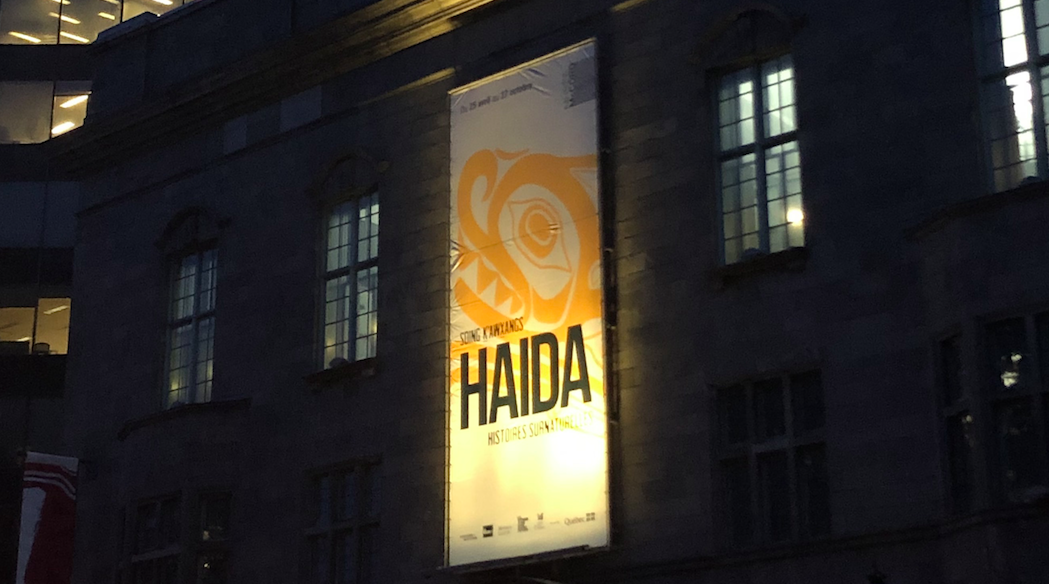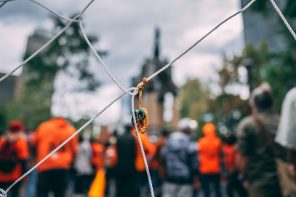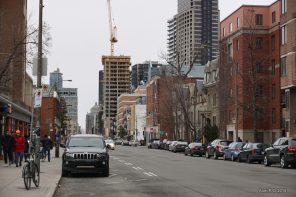Legends and mysteries, monsters and creators, triumphs and traumas – all of these are on display across campus, at the McCord Museum on Sherbrooke. The Haida Supernatural Stories exhibit is on until October 27th, sharing a blend of rare historical Haida art, as well as seven contemporary Haida artists, many of whom are women. The Haida are an Indigenous People based in the archipelago of Haida Gwaii in northern British Columbia for more than 17,000 years. In the exhibit, Haida culture is visible as an active culture that brings an irreplicable force to our society, rather than a “historical”, capsulated culture of the past to be marveled at.
This unique exhibit seeks to transport the Haida Nation’s rich culture, born from nature, to the heart of downtown Montreal. Though they are globally known for their art and culture, it’s irremovable from their lands. Inspiration drawn from the ocean, forests, and mountains of the Northwest coast of Canada seems to come alive with the addition of audiovisual content. The exhibit brings the vibrancy of the Haida culture to the public eye, rooted in a landscape so drastically different from Montreal.
Upon entering the exhibit, the atmosphere is in stark opposition to the bustling street outside, as the sounds of birds chirping and waves crashing echo from hidden speakers. This sensory experience suspends time, making it easy to forget everyday worries, as we are distracted by legends that erase temporality.
The exhibit brings the vibrancy of the Haida culture to the public eye, rooted in a landscape so drastically different from Montreal.
Before the legends come to life, the exhibit takes us through a linear history of the Haida People’s encounter with the British Empire; an acknowledgment of transgenerational violence that leaks into their identity, as evidence of their impenetrable strength. Visitors are reminded that the population of the Haida Nation shrunk from 20,000 to 600 people after the smallpox epidemic carried by European colonizers, making their ability to uphold and maintain their legacy almost unquestionably miraculous.
The exhibit displays the uncomfortable truth behind colonizers and settlers, some from Montreal, who took the land rights from the Haida, along with their totem poles, masks, baskets, and other objects of cultural identity. It highlights how far the Haida Nation have come and how long they have fought to preserve their legacy. Currently, the Haida stand against destructive logging on Haida Gwaii, marking a shift in power dynamics, as the Canadian government and the Haida Band negotiated joint management of the land. This historical timeline placed at the start of the gallery reveals the strength of Haida artists, whose work sustains their traditions.
Often, collections of Indigenous art in museums provoke feelings of unease, as I wonder how these pieces were acquired in the first place. However, the McCord Museum prioritized the inclusion of contemporary artists in the Haida Supernatural Stories exhibit and ensured its curation by a female Haida artist. The Haida culture is visible to the Montreal public as a piece of history, connected to the lives of real people, and an innovative, expanding, breathing culture that actively contributes to that which is outside itself; a culture still unfolding. By bringing together contemporary Indigenous artwork, it is clear to all who visit the exhibit that something incredibly real and powerful exists within the Haida community; something spiritual, and maybe even supernatural.
[The exhibit] highlights how far the Haida Nation have come and how long they have fought to preserve their legacy.
The Haida People’s supernatural stories do not feel like “stories” in the common-sense of the term. Instead, they feel like an explanation. Haida art remains connected to nature and the spiritual world, even in a museum thousands of kilometers away from its home, and artists thank their supernatural legacies for that. As written in the exhibition, “Haida Gwaii is filled with supernatural beings. Every prominent landmark and many places in the ocean, are dwelling places for supernatural beings which are deeply meaningful in Haida Culture.”
It feels as if the supernatural exists in every piece of Haida art. It speaks to us, in some way, of mountains rising and rivers bringing us to a different kind of world. The legends say that the Haida Nation’s supernatural ancestors “rose up from the ocean.” What if we thought, “and then what happened?” Because the Haida supernatural stories are alive in every piece of art and in every Haida person, their legends are passed on from generation to generation. Although the exhibit itself can only offer a glimpse into the beauty of Haida culture, the pursuit of such representation is important; because even in its simplest form, Haida’s supernatural stories are still affecting change.
Because the Haida supernatural stories are alive in every piece of art and in every Haida person, their legends are passed on from generation to generation.
Put beautifully by Haida curator, Kwiaahwah Jones, “[t]he story of how the Haida have survived from the immortal to the present is truly supernatural,” and the McCord exhibit seeks to show us just that. The life and spirit of the art whisper tales of land endowed with natural and supernatural beings that whisk us away to real places. The exhibit touches that inner part of us that wants to believe in a beautiful world endowed with visceral powers. The Haida Supernatural Stories exhibit is filled with supernatural beings if we let ourselves be open to their reception, and I think we should try.








